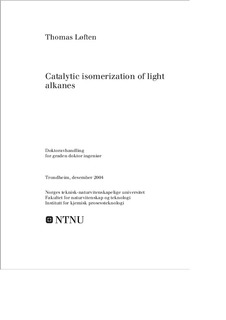| dc.description.abstract | In recent years the levels of sulfur and benzene in the gasoline pool have been reduced, and in the future there may also be new regulations on vapor pressure and the level of aromatics and olefins as well. The limitations on vapor pressure and aromatics will lead to reduced use of C4 and reformate respectively. The branched isomers of C5 and C6 alkanes have high octane numbers compared to the straight chain isomers, and are consequently valuable additives to the gasoline pool. To maintain the octane rating, it is predicted that an increased share of isomerate will be added to the gasoline pool.
Today there is a well established isomerization technology with platinum on chlorided alumina as the commercial catalyst for both isomerization of n-butane and of the C5/C6 fraction. This catalyst is very sensitive to catalyst poisons like water and sulfur, and strict feed pretreatment is required. Zeolites promoted by platinum are alternatives as isomerization catalysts, and has replaced Pt/alumina catalysts to some extent. The Pt/zeolite catalyst is more resistant to water and sulfur compounds in the feed, but it is less active than platinum on chlorided alumina. It does therefore require a higher reaction temperature, which is unfortunate since the formation of the branched isomers of the alkanes is thermodynamically favored by a low temperature.
Because of the limitations of the two types of isomerization catalysts, there is a search for a new catalyst that is resistant to sulfur and water in the feed and is highly active so it can be operated at low temperature. A new type of catalyst that seems to be promising in that respect is sulfated zirconia.
The first part of this study focuses on a series of iron and manganese promoted SZ catalysts. The catalysts were characterized by various techniques such as XRD, TGA, N2 adsorption and IR spectroscopy of adsorbed pyridine. The catalytic activity in n-butane isomerization at 250°C and atmospheric pressure was compared to the physical and chemical properties of the samples. No promoting effect of iron and manganese was found when n-butane was diluted in nitrogen. When nitrogen was replaced by hydrogen as the diluting gas the activity of the unpromoted SZ sample was dramatically lowered, while the activity of the promoted catalyst was not significantly changed.
If we only consider the promoted samples, the catalytic activity increases with increasing iron/manganese ratio. We also observe that the activity of the samples is clearly correlated with the number of strong Brønsted acid sites. The total number of strong acid sites (i.e. the sum of Brønsted and Lewis sites) does not change significantly when the promoter content is changing, hence no correlation between catalytic activity and the total number of acid sites is found. This underlines the importance of discrimination between Lewis and Brønsted acidity when characterizing the acidity of the samples.
The second part of this study is focused on a series of noble metal promoted sulfated zirconia. Their catalytic activity in n-hexane isomerization at high pressures was compared to a commercial Pt/zeolite catalyst. Among the noble metal promoted samples the catalyst promoted with platinum was the most active. The samples promoted with rhodium, ruthenium and iridium showed equal activity.
Common for all the noble metal promoted catalysts is the large increase in activity when catalysts are reduced with hydrogen compared to when they are pretreated in helium. The increase in activity is most likely connected to the reduction of the metal oxides of the promoters to ensure that the promoters are in the metallic state. Reduction at too high temperatures does however give lower activity. This is probably due to the reduction of surface sulfate groups leading to a loss in acid sites.
The commercial sample was considerably less active than the sample of platinum promoted sulfated zirconia. The commercial catalyst was however more stable than the PtSZ catalyst. All the sulfated zirconia catalysts deactivated, but the initial activity could be regenerated by reoxidation at 450°C followed by reduction at 300°C. The promotion with noble metals appears to inhibit coke formation on the catalyst. But, the main cause of deactivation of the platinum promoted sample is most likely the reduction of sulfate species leading to a loss of acid sites.
The kinetic study of the catalysts indicates that the n-hexane isomerization proceeds via a classical bifunctional mechanism where the role of the promoting metal is to produce alkenes, which are subsequently protonated on the acid sites. The reaction orders of hydrogen, n-hexane and total pressure are all in accordance with this mechanism. The activation energies of the catalysts are within the typical range of bifunctional catalysts.
All catalysts, except the unpromoted SZ sample, showed close to 100% selectivity to branched hexane isomers and a similar distribution of these isomers. The isomer distribution being the same for both the noble metal promoted catalyst and the Pt/zeolite is another indication that the isomerization proceeds via the bifunctional mechanism over the promoted samples. The different selectivity of the unpromoted SZ catalyst indicates that the isomerization proceeds via a different pathway over this catalyst; this is probably a pure acidic mechanism
The acidity characterization can not explain the differences in isomerization activity. It is however likely that the activity of the promoting metals in the dehydrogenation of alkanes is important since the classical bifunctional mechanism is prevailing. | nb_NO |
